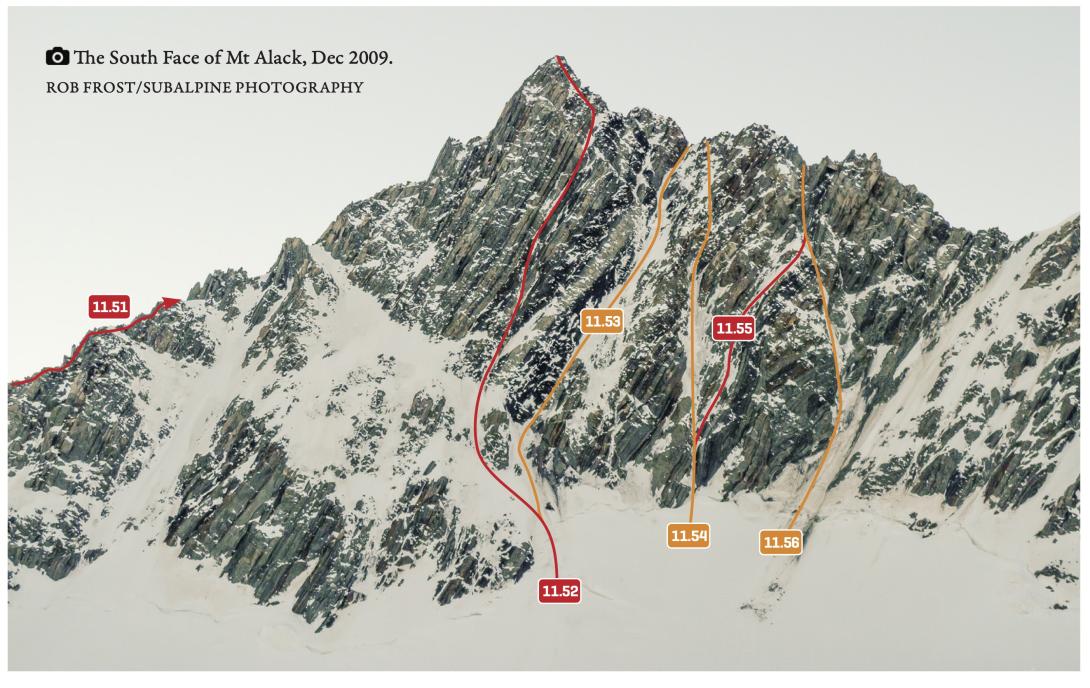Despite being a relatively small peak, Mt Alack is fairly steep, with no simple way off. The easiest descent is to scramble/pitch down either the North West Ridge or South West Ridge. If this idea makes you squeamish, go as far down either ridge as you feel comfortable, then abseil down the West Face to the Cleves Glacier. In winter, with two ropes, abseiling the south face on V-threads is usually the best option.
Over the years several ice routes have been climbed on the South Face. Who actually climbed them first is unclear, although most are claimed by Nick Cradock. The moderate angled snow on the far left of the face has been used many times as access to or from the South West Ridge.
Routes
| Reference | Title | Grade | Length | Pro | Quality | Alert | Operations |
|---|---|---|---|---|---|---|---|
| 11.49 | 11.49North West Ridge, II,3 | II,3 | 0m | ||||
|
Reportedly very loose, but in a great setting and begins very close to Pioneer Hut.
|
|||||||
| 11.50 | 11.50The TV Slab, 17 | 17 | 80m | ||||
|
On the left side (looking up) of the South West Ridge of Alack, above the Cleves Glacier, is a beautiful proud slab with a prominent hand crack near the top. It gained notoriety and a name when Graeme Dingle and Murray Jones climbed it for a TV crew during the 70s. Recently, Nick Cradock added a couple of bolt belays making this a must do route.
Pitch 1: climb 40m on good rock (grade 16) to a double bolt belay.
Scramble up loose but not obnoxious rock, past one bolt. You can use this as a runner but it was primarily placed for abseiling.
The TV Crack. A 40m, grade 17 hand crack that requires some bigger natural protection (#2 to #3 Camalots). Stonking. Double-bolt abseil rings at the top. Two ropes are required for abseiling off. |
|||||||
| 11.51 | 11.51South West Ridge, II,3 | II,3 | 0m | ||||
|
Better rock than the North West Ridge, but still loose in places. A few parties will want a rope for some short steps. If you’re tempted to descend
|
|||||||
| 11.52 | 11.52Alack Attack, III,5+ | III,5+ | 0m | ||||
|
A fairly direct seven-pitch line leading to the right of the summit. The first three pitches are on the icefields and the next four are on the upper wall. A good technical climb that usually involves some mixed ground.
|
|||||||
| 11.53 | 11.53Southern Gully, III,4 | III,4 | 0m | ||||
|
Six pitches of 50–60 degree ice.
|
|||||||
| 11.54 | 11.54Sharp, III,5 | III,5 | 0m | ||||
|
A steep start followed by a 50–60 degree gully for a couple of pitches. After the gully steepens and curves right, take the left branch to continue straight up, finishing near the top of Southern Gully.
|
|||||||
| 11.55 | 11.55Blunt, III,5+ | III,5+ | 0m | ||||
|
Shares its start with Sharp, but heads right, following a weakness over the buttress to join the upper pitches of Frank.
|
|||||||
| Frank, III,5+ | III,5+ | 0m | |||||
|
Start at the base of the gully below the Alack–Douglas col, but head left, parallel to Sharp. The upper mixed pitches provide the crux.
|
|||||||
Rob Frost (2018)
